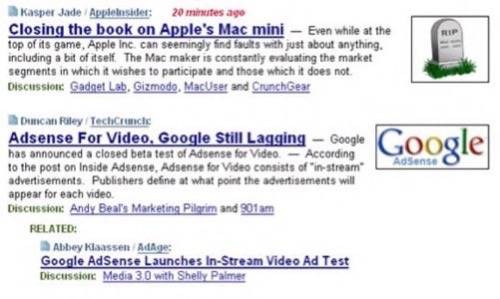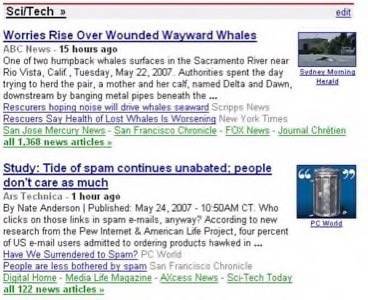Google News and Techmeme are two services that I use extensively every day. They are also two services whose technology is way over my head and are both eminently impressive. But Google News could, in my opinion, learn a lot from Techmeme, which has no rival when it comes to tech buzz aggregation. And Techmeme could learn a few things from Google, too.

It should probably be noted that Google News and Techmeme have very different aims. Google News aggregates news from across a broad spectrum of categories, mostly from mainstream sources. Techmeme, on the other hand, highlights buzzworthy news from a focused niche (technology), mostly from blogs. But they are very similar beasts. They both aggregate news very well and algorithmically decide what are the top breaking stories of the day.

Display
The most immediately noticeable difference between the two services is in their display. This is one area I think Techmeme really shines. Techmeme’s display is elegantly simple, easy to read, and usually compact (except when a monster meme evolves, such as the iPhone announcement). Google’s display is also compact an easy to follow, and their sheer number of sources likely makes it impossible to list every contributing source at once the way Techmeme does.

But Google’s display does some things I don’t like, as well:
- It constantly shifts – This again may be a product of the massive number of sources, but Google News can never decide who controls the meme. I am guessing that Google’s algorithms rely more on semantic analysis and Techmeme’s rely more on linking, which probably makes it harder to decide which story to keep on top, but every few minutes, Google news looks very different, which can make it hard to find the story you were just looking at. Techmeme, on the other hand, generally decides on a few top memes over the course of a day, and feeds them (this process is, of course, exaggerated since many — most? — tech bloggers watch Techmeme and chime in with their own two cents on popular stories). It shifts, but not much and not every few minutes.
- About those sources… – Google News gets content mainly from mainstream newspapers, which means a ton of duplicate sources from the Associated Press, Reuters, and other wire services. When you see Google News quoting 3,500 news articles in a single meme, how many of them are repeats? Listing all the duplicate sources certainly has its place (sometimes a wire article will be presented with an optional trim — meaning you can find a more detailed version elsewhere, or sometimes you just want to find the article on a more attractive page), but I wish it was divorced from the main service. Techmeme, because it handles mostly blog content, rarely displays duplicate articles. It’s nice to be able to scan through multiple viewpoints from different sources on the same topic.
- Limited number of stories – Google News shows a maximum of nine stories per section. This makes sense for a generic page, where multiple topics need to be displayed on the page at once. But the restriction makes less sense for a customized page that could theoretically only display one or two topic areas. Techmeme, because it is more narrowly focused, has the luxury of displaying many more stories at once.
- River of News – Techmeme has a River, which shows breaking news stories chronologically throughout the day. This is an incredible feature that allows you to keep on top of buzz as it heats up. As I said, it can be hard to keep on top of news with Google’s service since it shifts so often. A timeline of the day’s news would be a great addition.

Timeliness
Techmeme feels more timely than Google. Even though I said Techmeme keeps its top stories in place longer than does Google News, it also seems to find new memes within 15-30 minutes of when they break. Google News finds stuff quickly, but often displays articles that are 18-20 hours old because the meme is still being pumped (many times by duplicates from the wires being pushed out to newspapers late).
Archives
The constant shifting of Google News’ homepage and the limited number of stories you can display at once per category often means news slips by without being seen. The lack of a proper archive means some of those stories may never be seen. If I want to know what yesterday’s headlines were — or even this mornings — I am out of luck. Techmeme, provides a very comprehensive archive. Enter any date and time and instantly view how the Techmeme page looked at that moment in history. What Google News does offer, is archive search…
Search
My biggest gripe with Techmeme has always been its lack of a search feature. In order to find the link to the iPhone announcement meme I linked to above, I had to first remember that the Steve Job’s MacWorld keynote was on January 9th, and then load up that page at the correct time of day. It would have been great if I could have looked up “iphone announcement” and been directed to the blog posts I was looking for (we’ll pretend I was actually after the posts and not the meme link).
Google News has always had search, and great search because this is, after all, Google. The only check against it was that it didn’t go back very far in time. You couldn’t search for last year’s news, or in some cases, last month’s news. But Google recently introduced News Archive Search, which allows users to search an archive of news stories back to the 1920s (or before). The results are a sometimes a bit odd and out of order, but it is infinitely useful as a research tool regardless. The search also has a timeline feature, that attempts to assemble a timeline of the top news throughout history on a certain topic. Sometimes its choices are rather perplexing, however. Check out this timeline of Einstein and you’ll see what I mean.
Conclusion
These are both services that I use every day and rank among the most useful in my arsenal of online tools. Neither is perfect, but both are marvels of engineering (to me, anyway) and the people behind them deserve my thanks for creating something so integral to my daily routine. I think the two services can learn from other another, though, and each become even better at what they do.










